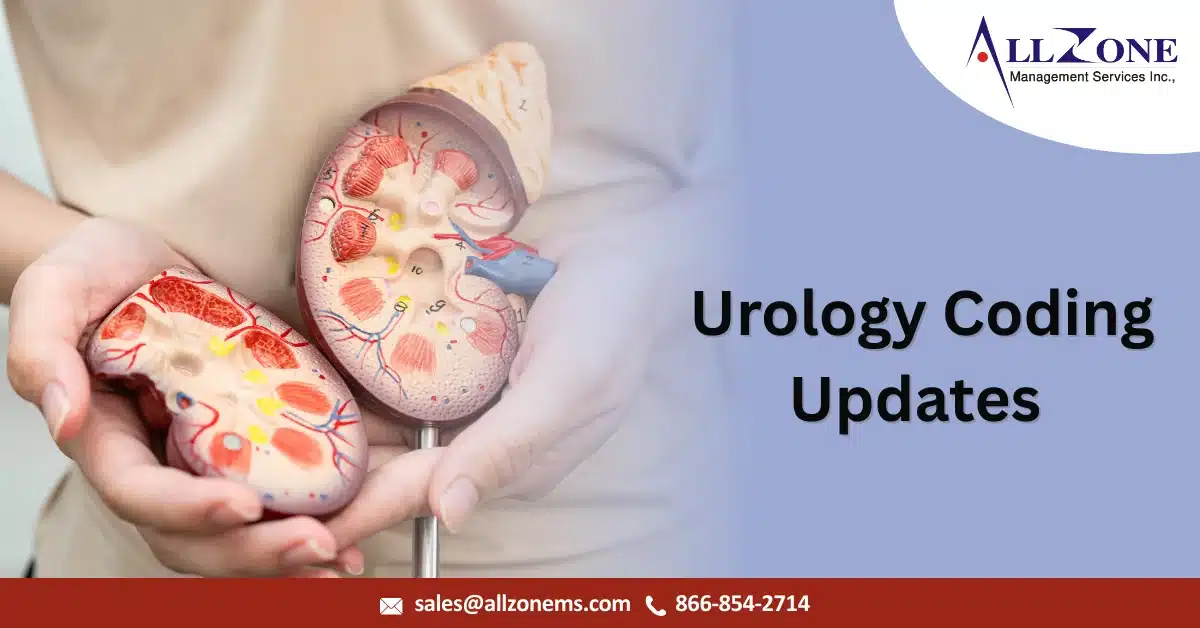Staying updated with Urology Coding Updates 2025 is critical to ensure compliance, accurate reporting, and optimal reimbursement.
AMA’s release of the CPT 2025 code set: 270 new codes, 112 deletions, 38 revisions
- The CPT code set continues to expand in new areas of medicine with proprietary laboratory analyses assigned to the largest proportion of new codes (37%), mostly for novel genetic testing. Category III CPT codes for emerging medical services accounted for about a third of new codes (30%).
- Medicare’s National Correct Coding Initiative (NCCI) / Policy Manual — in particular Chapter 7 dealing with urology, endoscopic/genitourinary system procedures.
Key updates in the CPT 2025 code set include:
Digital medicine
Remote therapeutic monitoring (RTM) services underwent editorial revisions. Code 98975 was updated to include digital therapeutic intervention, while codes 98976-98978 were revised to include device supply for data access or data transmissions to support RTM of patients.
Major Updates & General Rules
Here are the new/important coding changes and rules in 2025 that are especially relevant to urology:
1. New / Revised CPT Codes of Interest
-
- New technology and procedures (for example, AI-augmented imaging/procedures, “image-guided prostate biopsy” category III codes) have been added.
- Revisions/deletions of some older codes to reflect obsolete techniques or to better define specificity.
2. NCCI Chapter 7 Rules (Medicare’s Policy for Urology / Genitourinary Procedures) — important “do’s & don’ts”:
-
- E/M (Evaluation & Management) codes should not be reported on the same date as a minor surgical procedure, unless there is a “significant, separately identifiable E/M” service. Use modifier 25
- Minor procedures, diagnostic endoscopies, etc., often include other actions (e.g. biopsy during cystourethroscopy) as part of them; those included components are not to be coded separately.
- Fluoroscopy (e.g. CPT code 76000) is “integral” to many endoscopic genitourinary procedures — so you cannot report it separately with the endoscopic procedure.
3. Procedures with “separate procedure” in descriptor — those may have limitations under NCCI PTP edits. If a procedure is considered “separate” but is done with another in the same anatomical area / the same approach, it may be disallowed unless a modifier applies.
4. Global Surgical Package / Included Services
-
- As always, services included in the global surgical package (such as pre-op, post-op care, and routine follow up) cannot be billed separately.
- Also, insertion of urinary catheters, wound closure, control of bleeding, etc., if they are integral, are not separable.
5. Diagnosis Coding Specificity
-
- With ICD-10 (or equivalent diagnosis code sets), increasing emphasis on specificity: e.g. location of bladder tumour, laterality, type of incontinence, etc. Unspecified codes are more likely to trigger denials.
6. Use of Modifiers & Bilaterality
-
- Modifier 50 (bilateral), RT/LT modifiers where appropriate. Be sure to follow guidance whether the code is intrinsically bilateral or not.
- Modifiers like 25, 59, XS, etc., for separate or distinct services, separate lesions, etc., but only if supported by documentation.
7. Payment / Reimbursement Guides
-
- The Boston Scientific “Prostate Health 2025 Coding & Payment Guide” provides expected reimbursement amounts (Medicare national average) and facility vs. office, etc., for prostate-related procedures. Useful for bench-marking.
- AUA’s “CodingPlus (2025)” helps keep up with regulatory shifts (e.g. telehealth status, conversion factor changes, practice expense changes) that impact payment.
Common Pitfalls in Urology Coding (2025)
- Billing separate for components already included in a procedure.
- Using unspecified diagnosis codes when better specificity is available.
- Not using correct modifiers when needed (e.g. laterality, separate E/M, distinct procedural services).
- Overlooking new codes that might better describe a procedure (especially with new technologies).
- Misreporting units of service (for example, for removal of multiple calculi vs per procedure; Medicare’s MUE edits).
Commonly Coded Urology Procedures
| Category | CPT Codes (Examples) | Notes |
| Cystoscopy | 52000 (diagnostic), 52204–52287 (with biopsy, fulguration, resection, stone removal) | Bundling rules apply — many add-ons are already included. |
| Prostate Procedures | 55700 (biopsy), 55866 (laparoscopic prostatectomy), 55880 (laser ablation of prostate tissue) | Watch global periods and documentation of approach (open, lap, robotic). |
| Stone Management | 52332–52356 (ureteroscopy, lithotripsy, stent insertion), 50590 (ESWL) | Stent placement (52332) is not separately billable if done at the same session as stone removal unless unrelated. |
| Catheter/Drainage | 51701–51710 (insertion/change), 51798 (uroflow), 51741 (complex uroflowmetry) | Catheter insertion is often bundled into major surgeries. |
| Male Reproductive | 55250 (vasectomy), 54405 (penile prosthesis), 54520 (orchiectomy) | Check laterality modifiers (RT/LT). |
| Female Urology | 57288 (sling procedure for stress incontinence), 53440 (pubovaginal sling), 53620–53661 (urethral dilation) | Bundling edits apply if performed with cystoscopy. |
| Oncology | 51590 (radical cystectomy), 50545 (lap nephrectomy), 50593 (percutaneous ablation, renal tumor) | Use correct pathology diagnosis codes (C61, C64, C67, etc.). |
| Other Urodynamics | 51726–51797 (urodynamics studies), 51784 (EMG of anal/urethral sphincter) | Report only if documentation supports full test components. |
Why Urology Practices Must Stay Updated
The Urology Coding Updates 2025 not only reflect new technologies and Medicare rules but also reinforce compliance requirements. Providers who fail to adapt risk denials, reduced reimbursement, and compliance penalties. Staying informed ensures that practices can accurately capture revenue while maintaining adherence to AMA, Medicare, and payer-specific rules.

